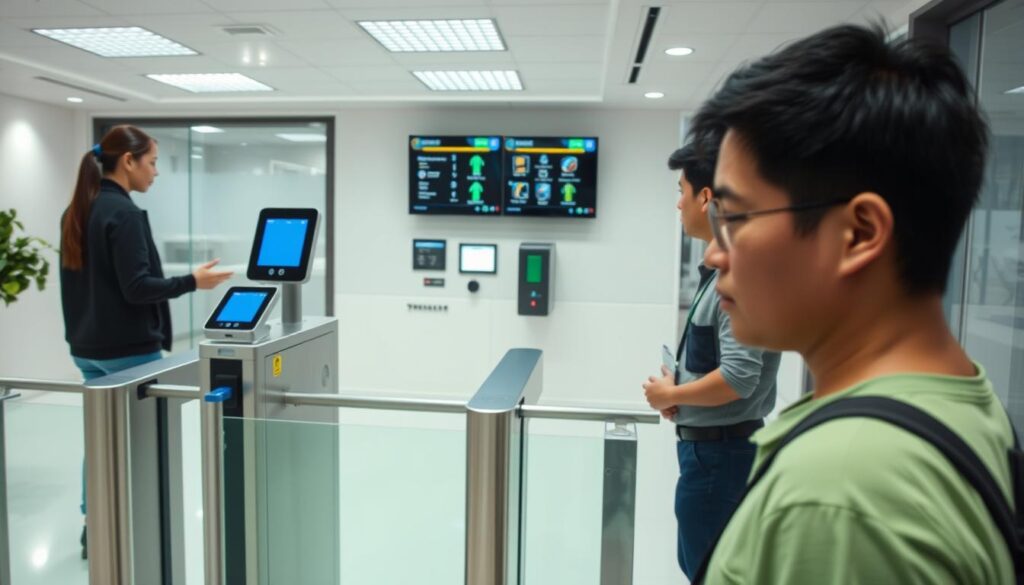Have you thought about how vulnerable your company’s attendance system might be to cyberattacks? With more digital tools for tracking hours and managing data, keeping information safe is key. Privacy is a big deal, and weak security can hurt businesses a lot.
Recently, companies in the Philippines got hit with fines over PHP 45 million for data privacy breaches. As attendance systems grow more important, learning to manage data securely is crucial. It’s not just about tech; it’s about keeping your business and employees safe.
Key Takeaways
- Data security is essential for protecting sensitive information in attendance systems.
- Organizations that prioritize data security can experience significantly fewer security incidents.
- Violations of data privacy can result in substantial fines and loss of business reputation.
- Regular audits and testing lower the costs associated with potential data breaches.
- Enhancing security measures improves employee trust and operational efficiency.
Understanding Data Security in Attendance Management Systems
Data security is about keeping sensitive information safe from unauthorized access and theft. In attendance management systems, it means protecting employee records, attendance logs, and payroll details. It’s crucial for organizations to have strong data security practices. This is because the cost of cybercrime is expected to hit 344 trillion pesos a year.
Definition of Data Security
Data security is about keeping data safe and sound. It uses encryption, access controls, and secure management to do this. These methods help keep employee information private and safe from threats.
Importance of Data Security for Organizations
Data security is very important. A big 60% of organizations have faced data breaches in the last two years. This is because their time and attendance systems weren’t secure enough. By 2023, most attendance management systems will face big problems with data privacy and security.
| Statistic | Impact |
|---|---|
| 60% of organizations experienced a data breach | Highlighting the urgent need for secure data management |
| The average cost of a data breach is about 221 million pesos. | Financial consequences can be devastating for organizations |
| 67% reported breaches due to vulnerabilities | Indicates a critical focus on secure data management |
| 46% of businesses faced a cybersecurity incident | Emphasizing the prevalent risks to data security |
Data breaches can hurt a company’s finances and reputation. They can also damage trust with employees. So, it’s key for all organizations to have good data protection plans.
The Risks of Inadequate Data Security
In recent years, the weaknesses in attendance systems have become clear. This is mainly because of poor data security. Schools and universities are now seeing the big problems caused by data breaches. They need accurate attendance tracking to function well.
Statistics on Data Breaches in Attendance Systems
A recent EDUCAUSE poll showed that 70% of universities have faced malware attacks. Weak file transfer methods are behind 65% of data breaches. This shows how big the data security risks are in these systems.
Many times, data gets exposed because of theft or loss. Schools also use third-party APIs, which can be risky if not checked well.
Potential Financial Consequences of Data Breaches
Data breaches can cost schools a lot. They might have to pay fines, legal fees, and deal with bad publicity. For example, in 2021, the Indian Institute of Technology, Bombay faced a breach affecting 22,000 students.
This shows why schools need to protect their data well. They should avoid accidental deletions and unauthorized access. Also, using external apps can be risky. Schools need to check their data practices often.
Following rules like GDPR and using access controls can help a lot. This makes data in attendance systems safer.

Data Security Best Practices for Attendance Systems
Keeping attendance systems safe is key. Strong security measures protect employee data from cyber threats. They also meet important regulations.
Implementing Encryption Protocols
Using strong encryption is a must. For example, 256-bit encryption makes data unreadable to hackers. This has led to a 95% drop in security issues for some companies.
Encrypting data greatly reduces the risk of a breach.
Utilizing Multi-Factor Authentication
Multi-factor authentication is crucial for system security. About 68% of companies use it to boost access control. It adds a layer of protection against unauthorized access.
This method effectively lowers the risk of data breaches.
Regular Software Updates and Audits
Regular updates and audits are essential. They keep data safe from vulnerabilities. Timely updates and audits help find and fix weaknesses.
Companies that audit regularly can cut errors by up to 50%. This makes attendance tracking more reliable.
Data Security and Employee Privacy
Keeping employee information safe is key for companies wanting to protect privacy. It’s important to keep personal data secure to make employees feel safe at work. If data is not protected, it can harm trust and morale in the company.
The Importance of Protecting Employee Information
Companies must focus on keeping employee data safe to build trust. Personal info and payroll details are at risk from cyber threats. Showing a strong commitment to data security helps build trust with employees.
This trust is vital for employee engagement and productivity. When employees feel their data is secure, they are more likely to be productive and feel valued.
Effects of Privacy Breaches on Trust and Morale
Privacy breaches can cause more than just financial loss. They can make employees worry about identity theft and financial loss. When a breach happens, a company’s reputation can suffer, leading to lower morale and more employees leaving.
For example, companies hit by data leaks see a drop in employee trust. This can lead to lower performance and less commitment from employees. Knowing how to handle employee data well can help keep a happy and dedicated team.
| Privacy Breach Impact | Employee Trust Level | Potential Consequences |
|---|---|---|
| Data Leak | Low | Increased turnover, decreased productivity |
| Effective Data Protection | High | Improved morale, enhanced engagement |

How Biometric Attendance Tracking Enhances Security
As companies focus more on keeping data safe, biometric attendance tracking stands out as a top choice. It uses unique body features to replace old password systems. This makes it harder for hackers to get into attendance records.
Biometric data, like fingerprints or faces, can’t be easily swapped like passwords. This makes it crucial to protect it well.
Understanding Biometric Authentication Methods
Biometric systems use four main ways to check who you are: fingerprints, facial scans, iris scans, and voice recognition. They work because everyone’s biometric data is unique. This makes it hard for others to pretend to be you.
Using strong encryption helps keep this data safe from hackers. It’s key for keeping biometric info secure.
Case Studies of Successful Biometric Implementations
Many stories show how good biometric attendance tracking is. For example, colleges have seen a big jump in security. A big retail store in the Philippines cut payroll mistakes by 33% with biometric systems.
These examples show better security and more work done. Some places even saw a 15% boost in how much work gets done.
Companies that use biometric systems with their software work better. They get accurate records and avoid fake ones. This builds trust with employees.
For more info on using biometric solutions, check out this comprehensive guide.
| Biometric Method | Unique Features | Security Enhancement |
|---|---|---|
| Fingerprint Scanning | High accuracy and user-friendly | Eliminates proxy attendance |
| Facial Recognition | Quick identification without contact | Prevents unauthorized access effectively |
| Iris Scanning | High reliability in unique identification | Reduced risk of identity theft |
| Voice Patterns | Convenient for remote access | Enhances security when combined with other methods |
The move to biometric attendance tracking is backed by strong evidence. It shows clear wins in security and how well things work. Schools and big companies see it as a smart investment. It boosts security and makes things run better.
The Role of Access Control Systems in Data Security
Access control systems play a key role in protecting sensitive data in attendance management systems. They make sure only authorized people can access certain data. This boosts overall data security and lowers the chance of data breaches.
Limitations of Data Access to Authorized Personnel
These systems set strict rules on who can see or change important data. They help fight off outside threats and manage risks from within. Studies show that limiting access can cut insider threats by up to 70%.
Using role-based access control (RBAC) can also help. It cuts down unauthorized access by 30% compared to other methods.
Benefits of Role-Based Access Control
Role-based access control offers many benefits for data security. It assigns permissions based on a person’s role in the company. This boosts both efficiency and compliance with data protection laws.
Access control systems also make work easier, cutting down on admin tasks by about 40%. They help keep customer trust and protect a company’s reputation. In fact, 95% of organizations say it’s key to managing trust.
| Benefit | Impact |
|---|---|
| Reduction in Data Breaches | Up to 80% with effective access controls |
| Decrease in Unauthorized Access | 30% lower incidents with RBAC |
| Cost Savings | Averaging about 221 million pesos saved per data breach. |
| Reduction in Recovery Costs | Significant decrease due to enhanced security measures |
| Faster Incident Detection | Security incidents detected 50% faster |

Regulatory Compliance and Data Security
Ensuring regulatory compliance is key for attendance management systems. It means following rules to protect employee data. Laws like GDPR and HIPAA have strict rules to avoid fines and legal trouble.
Overview of Relevant Regulations (GDPR, HIPAA)
GDPR requires clear data handling and only collecting what’s needed. HIPAA protects health info with strict security. Both are crucial for keeping data safe.
Breaking these rules can cost a lot. GDPR fines can be up to €20 million or 4% of annual revenue. HIPAA violations also come with big fines and harm to reputation.
Consequences of Non-Compliance
Not following rules can hurt more than just the wallet. It can damage reputation, lose customer trust, and disrupt operations. It’s hard to attract or keep clients without showing you follow the rules.
Strong data security is vital. Using tools like automated visitor management helps. It keeps data safe and follows the law. For more on keeping data secure, check out effective timekeeping software integration strategies.
Emerging Threats to Attendance Systems Security
The world of attendance management systems is changing fast. Cybersecurity trends show a big jump in attacks like ransomware and phishing. This makes it harder for companies to keep their data safe.
With 68% of companies facing data breaches, it’s clear we need strong data security. This is more important than ever.
Current Cybersecurity Trends and Risks
New threats are always coming. In recent years, big breaches have shown us where we’re weak. They’ve exposed how vulnerable our systems are when it comes to employee data.
A study showed that cyber threats like hacking and phishing cause 43% of data breaches. As new threats appear, we must stay ahead of them.
The Rising Importance of Continuous Monitoring
Continuous monitoring is key to fighting these threats. Tools and AI help us spot problems quickly. This lets us act fast.
By using these tools, we can cut down on how long it takes to find and fix problems. This helps us protect our data better.

| Cybersecurity Trends | Impact on Data Security |
|---|---|
| Increased sophistication of phishing attacks | Higher likelihood of data breaches |
| Ransomware attacks on organizations | Risk of data loss and financial damage |
| Adoption of AI in cyber-attacks | New vulnerabilities emerge |
| Emphasis on data protection regulations | Pushed for enhanced security measures |
| Need for ongoing employee training | Reduced human error incidents |
Future Trends in Data Security for Attendance Management
Data security in attendance management systems is changing fast. New technologies like AI, machine learning, and blockchain are coming. These will change how we keep data safe and secure.
AI and Machine Learning Applications in Cybersecurity
AI and machine learning are set to change cybersecurity. They can look at lots of data to find security threats. This makes it easier to spot problems and keep data safe.
Using AI can make detecting trends 25% more accurate. This helps plan better and reduces mistakes. It’s a big step forward in keeping attendance records accurate.
Blockchain Technology for Enhanced Security
Blockchain technology is a game-changer for data security. It makes data management more secure and transparent. This keeps employee information safe from hackers.
Many companies are looking into blockchain. They want to make sure their data is safe and reliable. This is a big step towards better data security.
Conclusion
Data security is key for managing attendance systems well. In the Philippines, companies must focus on strong security steps. This includes using encryption and biometric solutions to keep employee data safe.
With cyber threats growing, it’s crucial to follow privacy rules like GDPR. This ensures the safety of sensitive information.
Companies in the Philippines face big challenges. Sixty percent have had data breaches in the last year. Also, 79% of employees worry about their biometric data being misused.
This shows the need for clear data use practices and better privacy education. By asking for consent before using biometric data, companies can boost employee happiness by 30%. This builds trust in the workplace.
Using biometric attendance tracking makes work easier and cuts down on paperwork. But, keeping data safe is essential. It protects company assets and keeps employees trusting their employers.
Staying ahead in data security is crucial for success. It’s important for companies to keep up with digital changes and protect their data.
